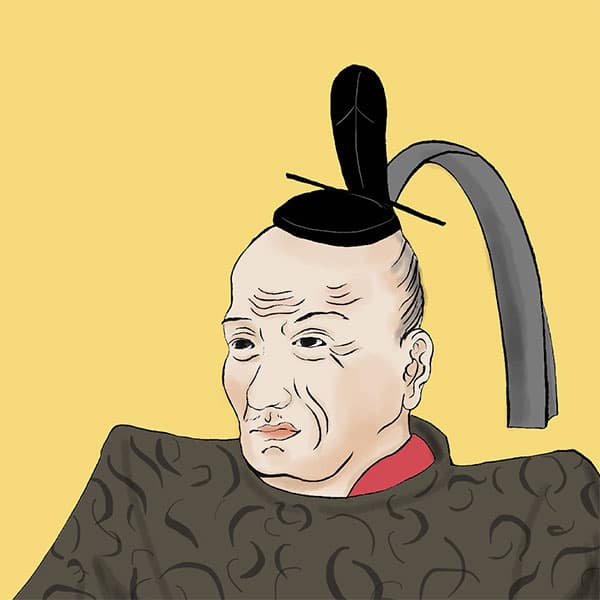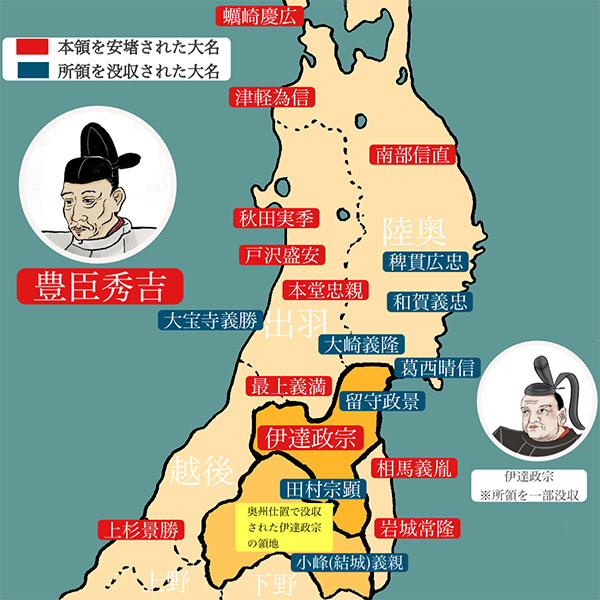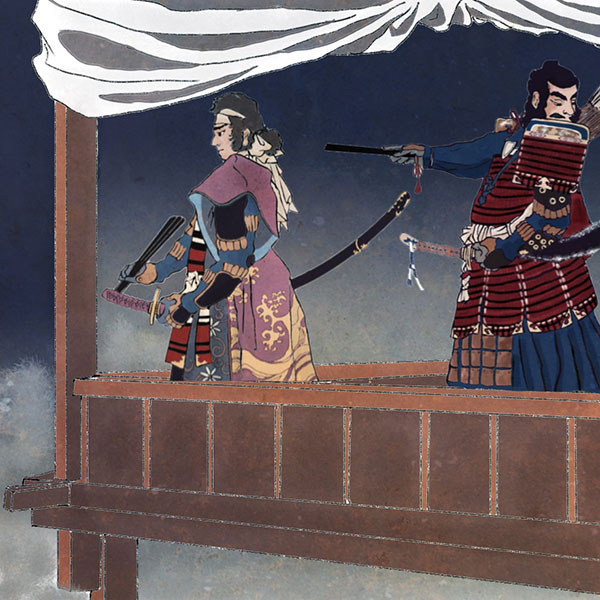Nobuyuki Sanada (2/2)The eldest son who protected the Sanada family

Nobuyuki Sanada
- Article category
- biography
- name
- Nobuyuki Sanada (1566-1658)
- place of birth
- Nagano Prefecture
- Related castles

Ueda Castle

Numata Castle

Matsushiro Castle
- related incident
The Sanada family's father and younger brother joined the Western Army, and the older brother joined the Eastern Army. Nobuyuki belonged to the Tokugawa Hidetada army, which led the main force of the Tokugawa family, and participated in the siege of Ueda Castle (Second Battle of Ueda). Before the battle, Honda Tadakatsu's son and Nobuyuki's brother-in-law (his wife Komatsuhime's younger brother), Honda Tadamasa and Nobuyuki, tried to persuade their father, Masayuki, but it is said that they ultimately failed.
Nobuyuki was ordered to capture Toishi Castle, which was being defended by Nobushige, but in order to avoid wasting the Sanada soldiers, he dispatched a messenger requesting the surrender of the castle, and his younger brother Nobushige agreed to surrender the castle as well. Nobuyuki defended the castle after entering it, and Nobushige withdrew to Ueda Castle where Masayuki was staying.
The battle between Tokugawa Ieyasu and Ishida Mitsunari was won by Tokugawa Ieyasu. However, Hidetada Tokugawa's main army was stopped by Masayuki Sanada, and Ieyasu's messenger was delayed, so they arrived late at the Battle of Sekigahara and were unable to participate in the main battle.
After winning the battle, Nobuyuki received his father Masayuki's possessions and inherited Ueda Castle. On the other hand, severe punishment awaited his father Masayuki and younger brother Nobushige, who lost the battle. Nobuyuki asked for a plea to spare the lives of his father and younger brother, and thanks to the efforts of his father-in-law, Tadakatsu Honda, Masayuki and others' lives were spared and they were exiled to Mt. Kudo, Kii Province.
Afterwards, Nobuyuki asked the shogunate for permission to hold a funeral when his father passed away, but it was denied.
Numata domain
After the Battle of Sekigahara, Nobuyuki Sanada was given an additional 30,000 koku in addition to Masayuki Sanada's old territory and became the lord of Ueda. Tokugawa Hidetada attacked Ueda Castle, which Masayuki had defended, and was ordered to destroy it. Nobuyuki will continue to be based at Numata Castle.
When Nobuyuki took over the Ueda territory, the territory was in ruins due to the devastation of battles and the successive eruptions of Mt. Asama, and after that, natural disasters such as unseasonable weather continued to occur one after another. Nobuyuki struggled to rebuild the territory by implementing various policies such as improving the town of Ueda Castle, installing weirs and irrigation water, and reducing annual taxes for the suffering people of the territory.
During the battle between the Tokugawa family and the Toyotomi family that began in 1614, he was unable to take part in the Battle of Osaka due to illness, so his eldest son Nobuyoshi and second son Nobumasa went on their behalf. In 1622, the area was expanded and relocated to Matsushiro, Shinano Province.
In 1656, his eldest son Shinkichi Sanada and his legitimate grandson Shinkichi's eldest son Kumanosuke passed away, so he handed over the headship of the Matsushiro domain in Shinano Province to his second son Nobumasa and retired. However, in 1658, his second son Nobumasa also passed away.
From this point on, the Sanada family started a battle for succession. When Komichi, the son of the deceased second son Nobumasa, inherited the domain, Nobutoshi, who was descended from the eldest son, objected to Komichi's succession to the family headship, which was descended from the second son, and filed a lawsuit with the shogunate. A commotion ensued that involved the shogunate and related feudal lords. Eventually, his second son, Yukimichi, became the third lord of the domain, and Nobuyuki returned to take charge of the domain because he was only two years old. Nobutoshi, a descendant of Nagayasu, became independent as the Numata domain.
Once the issue of succession had settled down, Nobuyuki Sanada passed away in October of the first year of Manji. Passed away at the age of 93.
His grave is located at Daihoji Temple in Nagano City, Nagano Prefecture, and his portrait is also in the collection. In addition, the Sanada family's family temple, Sanadayama Chokoku-ji Temple, houses the graves of successive feudal lords, including the mausoleum of Nobuyuki, the founder of the domain.
Portrait of Nobuyuki Sanada
Nobuyuki Sanada married Komatsuhime, the daughter of Honda Tadakatsu, one of the Tokugawa Four Heavenly Kings, and devoted himself to the Tokugawa family. On the other hand, his father and younger brother Masayuki Sanada and Nobushige Sanada (Yukimura Sanada) rebelled against the Tokugawa family through the Battle of Ueda and the Siege of Osaka. Because some members of the Sanada family often joined Masayuki and Nobushige's side, they were looked down upon by the Tokugawa family and devoted themselves to the shogunate.
Nobuyuki, who ruled the domain during the Edo period, lived a long life at the age of 93. Furthermore, he worked for the Sanada family as the lord and guardian until just before his death. It is said that Tokugawa Yorinobu, the son of Tokugawa Ieyasu and the founder of the Kishu Tokugawa family, respected Nobuyuki and invited him to his residence and listened intently to Takebe's stories. Nobuyuki and the Kishu Tokugawa family were so close that there is an anecdote that Nobuyuki later became the guardian of Yorinobu's child.
When Nobuyuki died, it is said that many people defied the restraints of those around them and became monks. It is said that everyone from Nobuyuki's vassals who served close to him to the peasants who lived in his territory were deeply saddened, and the peasants and townspeople also performed Buddhist services to pray for his soul. It is said that he was a great prince who was admired by both his vassals and the people of his territory.
Nobuyuki's death haiku was, ``Everything in this world changes with time, and I never thought of it as just a dream.'' Serving Katsuyori Takeda of Kai, he lived a war-torn world surrounded by the Oda, Uesugi, and Hojo families, and after passing through the Toyotomi government, entered the Edo period with the Tokugawa family at the head, and the territory was restored in a peaceful era. Nobuyuki Sanada has lived a life of rapid change and has struggled to manage the business.
Places related to Nobuyuki Sanada
- Sanada family and Numata castle
- Numata Castle was located in Tone District, Ueno Province (currently Numata City, Gunma Prefecture).
In 1580, Masayuki Sanada, who served the Takeda clan, captured Numata Castle, which belonged to the Hojo clan in the Kanto region, through an arrangement. After that, it temporarily left Masayuki's hands, but when the Hojo clan was destroyed by Toyotomi Hideyoshi in 1590, it came under the control of Nobuyuki Sanada, and it remained Sanada territory even into the Edo period.
In 1681, he became the lord of the shogunate and separated from the Sanada family.
Numata Castle was designated as a historic site by Numata City in 1976. One existing castle gate is located in Kawaba Village, Gunma Prefecture, and about three other castle gates have been relocated outside of Kawaba Village. The castle bell, which was cast by Shinkichi Sanada in 1634, still exists and has been designated as an important cultural property by Gunma Prefecture, and is on display at the Numata Historical Museum, which opened in Terrace Numata in 2019. - Sanada family and Matsushiro domain
- Matsushirohan was located in Hanishina District, Shinano Province (present-day Matsushiro, Matsushiro Town, Nagano City, Nagano Prefecture) during the Edo period. His castle is Matsushiro Castle in Nagano City, Nagano Prefecture, and he rules over four counties on Kawanakajima.
In 1622, Nobuyuki Sanada acquired the area from the Ueda domain of Shinano Province for 130,000 koku, and the land continued to be owned by the Sanada family until the end of the Edo period.
Nowadays, some of the buildings from that time have been relocated and it is now Matsushiro Castle Ruins Park. In 2004, the Taikomon gate, moat, stone walls, earthworks, etc. were restored to the park. It was selected as one of Japan's top 100 castles in 2006.
In 1964, part of the castle ruins, including the main castle keep, was designated as a historic site by Nagano Prefecture. In 1981 (Showa 56), part of the castle ruins, including the main castle keep, and the new palace were designated as national historic sites. - Chokokuji Temple Tomb of Nobuyuki Sanada
- Chokoku-ji Temple in Matsushiro City was built in 1622 when Nobuyuki Sanada moved from Ueda Castle to Matsushiro Castle as the founder of Hasedera Temple in Sanada no Sato, and is the family temple of the Sanada family. .
It is a place connected to the Sanada family, including the mausoleum of Nobuyuki Sanada, the memorial monuments of Yukimura Sanada and Daisuke Sanada, the graves of successive feudal lords of Matsushiro, and the memorial monuments of Yukitaka Sanada, Masayuki Sanada, and Nobutsuna Sanada. - Statue of Nobuyuki Sanada and Princess Komatsuda
- The statues of Nobuyuki Sanada and Princess Komatsatsu are located in Numata Park, near the former Honmaru ruins. Numata Park is the site of Numata Castle, where Nobuyuki Sanada was the lord. The Sanada family also has ties to Numata.
Sanada family and Ueda castle
Ueda Castle is a Japanese castle located in Ueda City, Nagano Prefecture. It was a flat castle built in 1583 by Nobuyuki Sanada's father, Masayuki Sanada. The turret that remains today was rebuilt by the Sengoku family during the Kanei era in the early Edo period.
It became the center of the battle to stop Tokugawa Hidetada in the Battle of Sekigahara, and was destroyed by the victorious Tokugawa family in the following year, 1601.
Nobuyuki, who took over the territory of Ueda, set up a mansion on the site of the Sannomaru ruins of Ueda Castle and used it as the domain office, and ruled by making Numata Castle in Ueno Province his main castle. Around this time, the castle town began to be maintained.
Nobuyuki Sanada was transferred to Matsushiro, Shinano Province in 1622. The Sanada family was transferred to Ueda, and the Sengoku family, which had ruled Komoro, was transferred to Ueda. The Sengoku family, who had relocated, applied to the Shogunate for the reconstruction of the destroyed Ueda Castle. Ueda Castle, which was rebuilt by the Sengoku family, had seven turrets built in the main keep, two turret gates, and a wall connecting them. The exterior walls of the buildings, including the three turrets in the main enclosure that remain today, have a black appearance because they are made of waterproof boards made from soot and persimmon tannin.
In the Meiji period, the castle tower and other buildings were demolished and buildings were relocated outside the castle. All that remained within the castle were the stone walls and one turret on the west side. In the Showa era, the two turrets of the main keep that had been relocated outside the castle were restored to their original positions, and in the Heisei era, the turret gates and walls were restored to wooden construction.
Ueda Castle is now Ueda Castle Ruins Park, with the Ueda Castle ruins at its core, and is a place of relaxation for citizens, with rows of zelkova trees said to be 100 years old and about 1,000 cherry blossom trees.
Sanada Shrine, located on the ruins of the main enclosure, is said to be the castle that did not fall during the Battle of Ueda, and is a popular spot for students to pray for victory.
Reread Nobuyuki Sanada's article
- related incident

- WriterTomoyo Hazuki(Writer)I have loved history and geography since my student days, and have enjoyed visiting historical sites, temples and shrines, and researching ancient documents. He is especially strong in medieval Japanese history and European history in world history, and has read a wide range of things, including primary sources and historical entertainment novels. There are so many favorite military commanders and castles that I can't name them, but I especially like Hisashi Matsunaga and Mitsuhide Akechi, and when it comes to castles, I like Hikone Castle and Fushimi Castle. Once you start talking about the lives of warlords and the history of castles, there's a side of you that can't stop talking about them.








